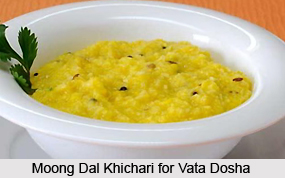 Moong dal khichari for vata dosha is an easy to digest nutritious preparation. Although this recipe is good for all doshas, it is especially beneficial for vata dosha. The primary ingredients for preparing this recipe are basmati rice, yellow split moong dal, ghee and some spices. It is easy to cook and can be made at home at any time.
Moong dal khichari for vata dosha is an easy to digest nutritious preparation. Although this recipe is good for all doshas, it is especially beneficial for vata dosha. The primary ingredients for preparing this recipe are basmati rice, yellow split moong dal, ghee and some spices. It is easy to cook and can be made at home at any time.
Ingredients of Moong Dal Khichari
•One cup of basmati rice
•Half cup of yellow split moong dal
•Three tablespoonful of ghee
•One teaspoonful of black mustard seeds
•One teaspoonful of cumin seeds
•Half teaspoonful of turmeric
•Two pinches of asafoetida
•Half teaspoonful of salt
•Four cups of water
Method of Preparing Moong Dal Khichari
Wash the rice and the moong dal. It is better to soak the moong dal few hours before cooking as it becomes easier to digest. For cooking khichari, it is advisable to use a cooker or saucepan. The food should be cooked in medium heat. First, ghee is heated and mustard seeds are added with cumin and hing. Then after a few moments, the seeds start popping. Add the moong dal, rice, turmeric and salt and stir for five minutes till it is well blended.
After this, water should be added and it should be made to boil for five minutes, uncovered and stir it occasionally. The flame should be lowered and the cooker or saucepan should be covered leaving the lid slightly open. It should be cooked this way for nearly half an hour.
Benefits of Moong Dal Khichari for Vata Dosha
There are various health benefits of moong dal khichari. Some of the key benefits are:
•Moong dal which is one of the main ingredients of this recipe ensures myriad health benefits. It aids in weight loss, lowers cholesterol levels, produces resistance against infectious diseases and promotes heart health.
•Rice being cold in potency, nourishing in nature mainly alleviates pitta dosha, without aggravating kapha and vata doshas and is easier to digest.
•The preparation is very filling and healthy and is easy to digest.
•It gives a grounding, calming and warming effect.
•The recipe is a balance of carbohydrate and protein.




















